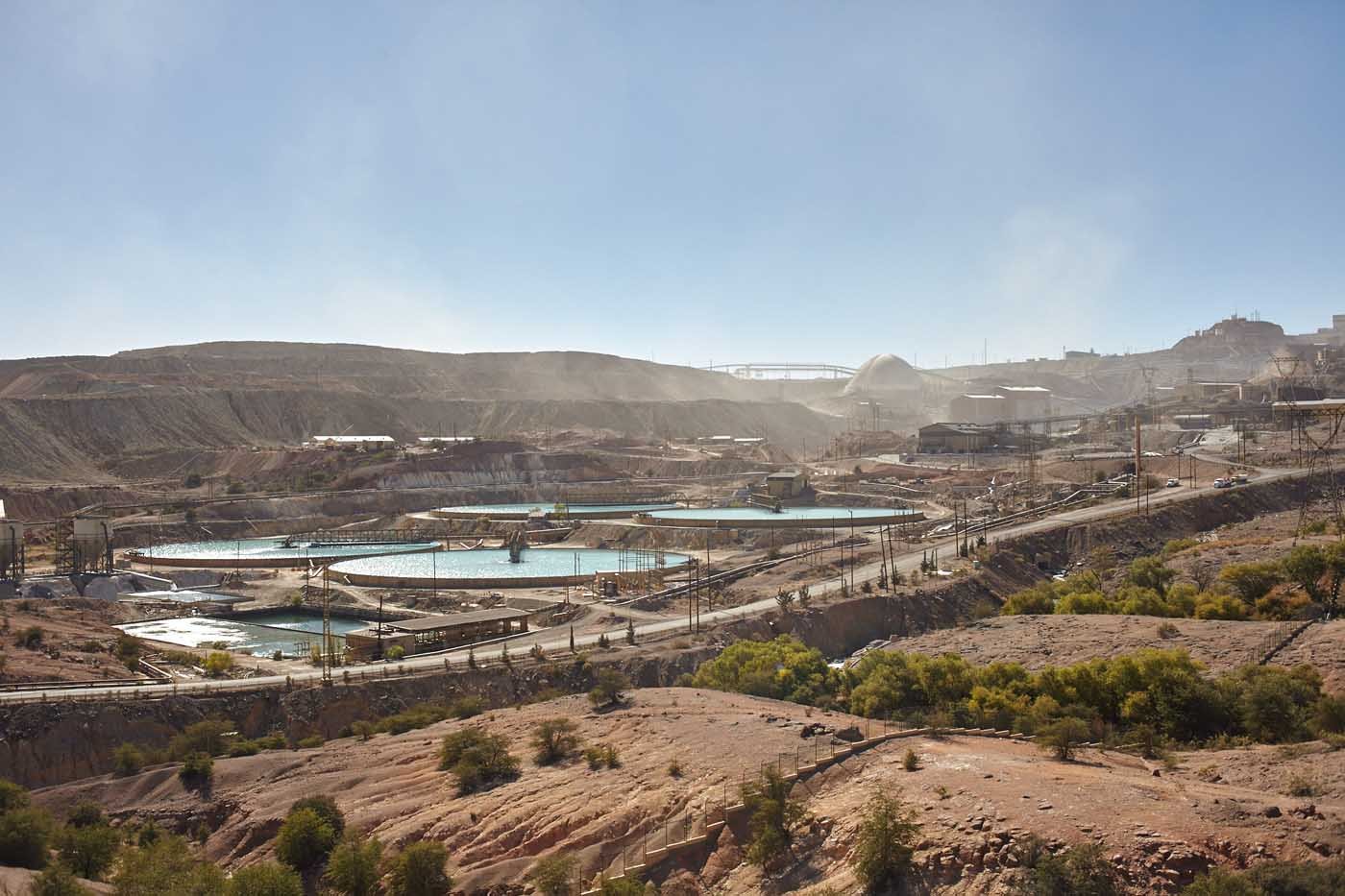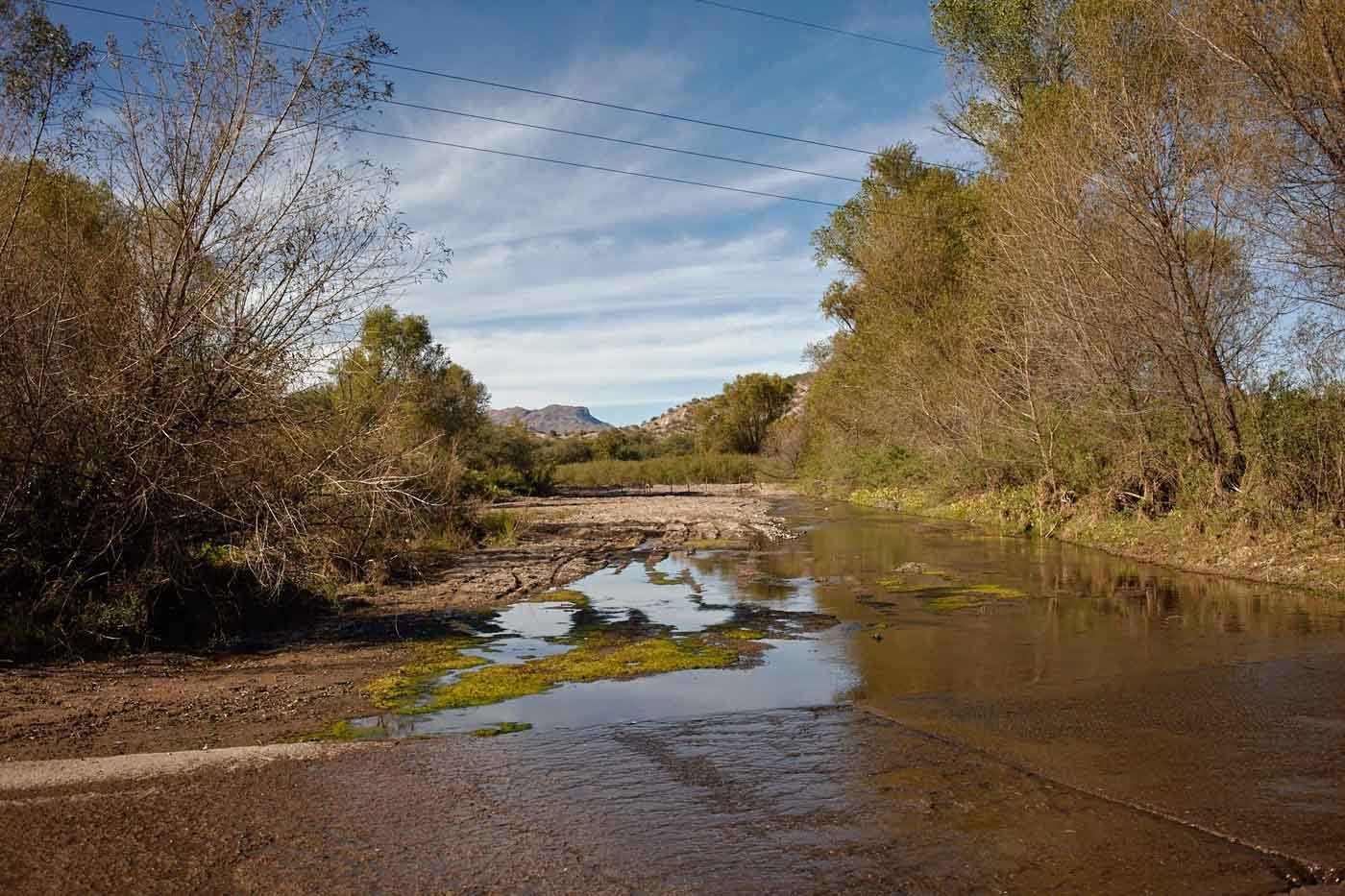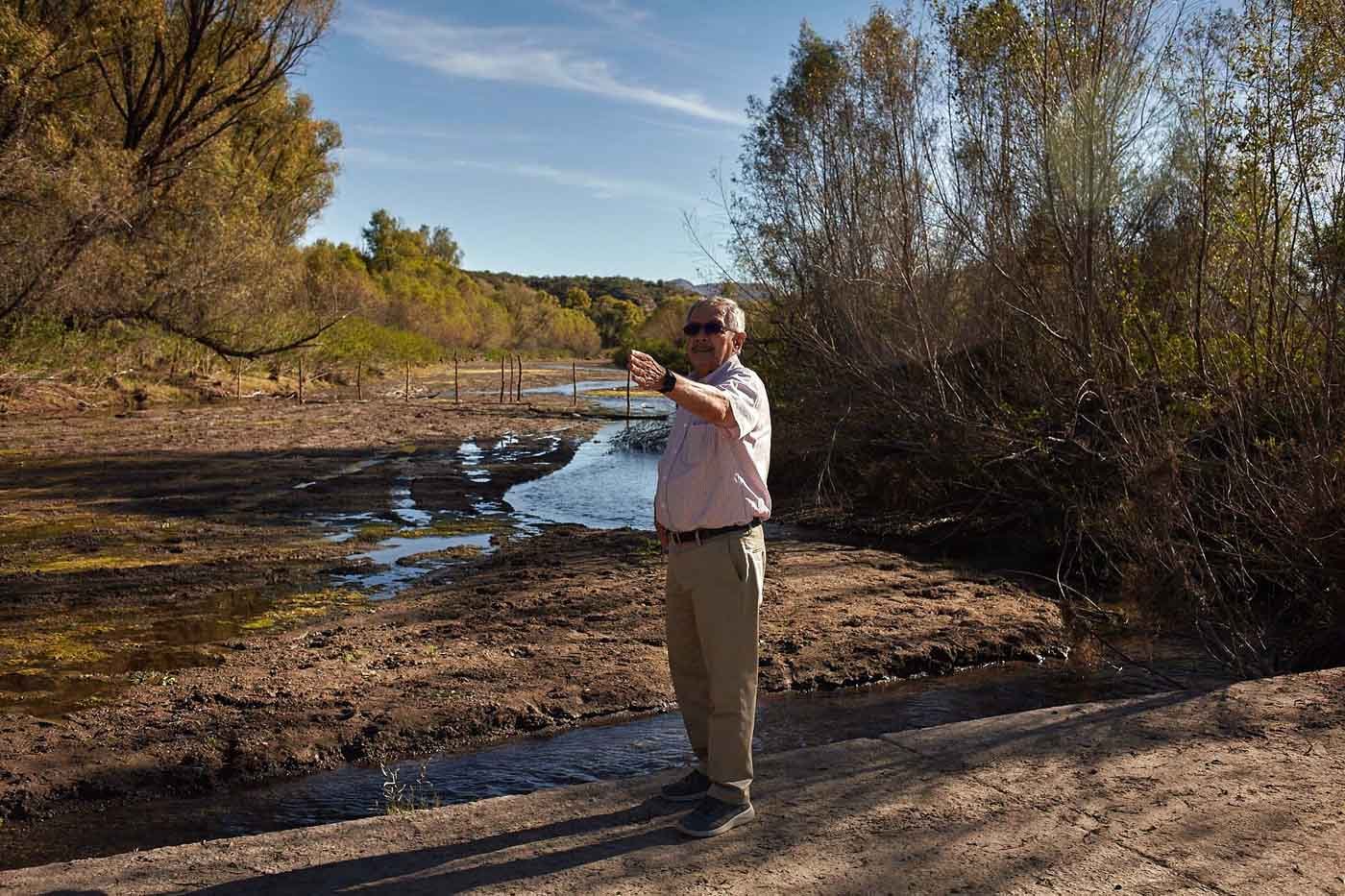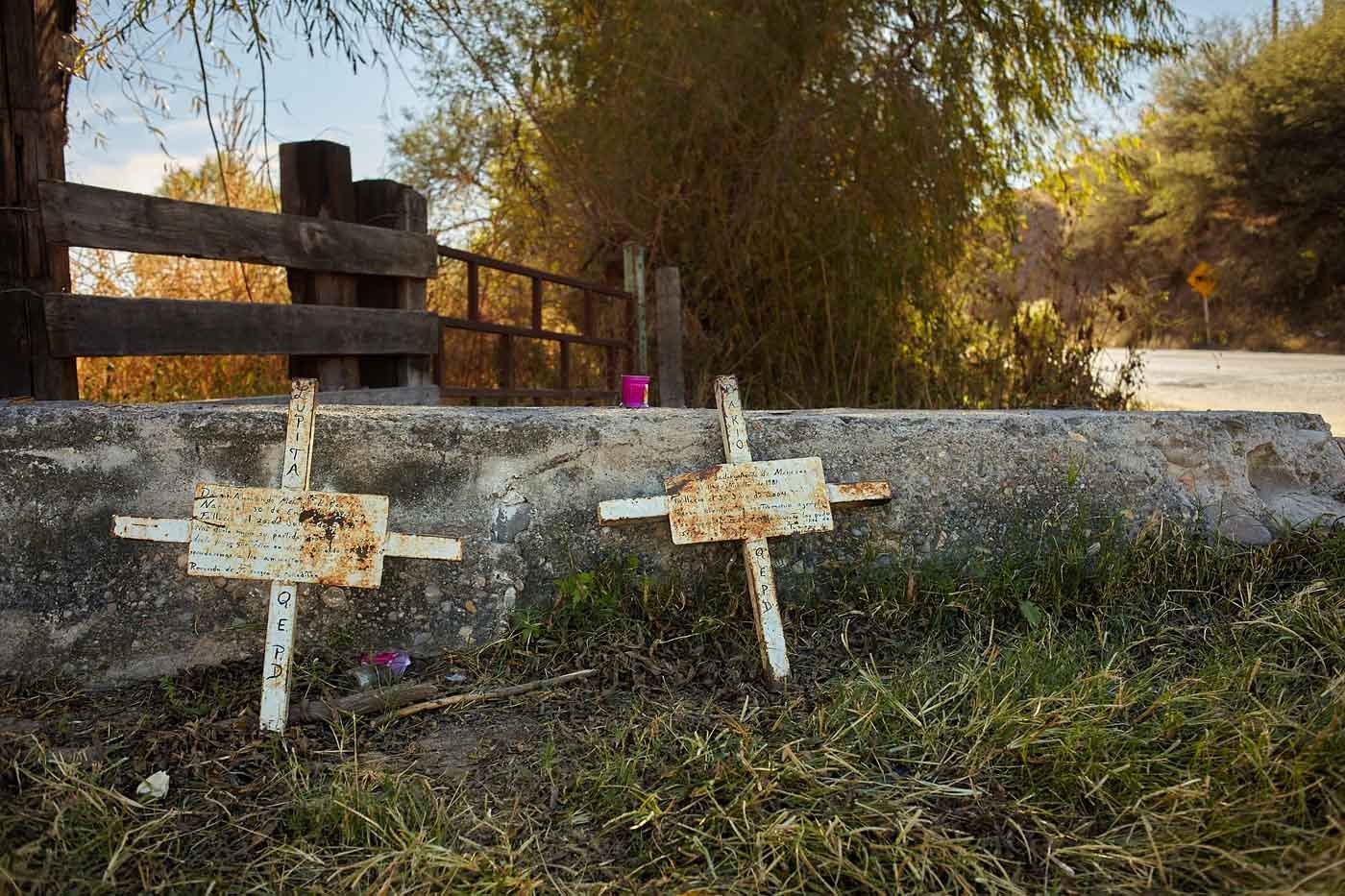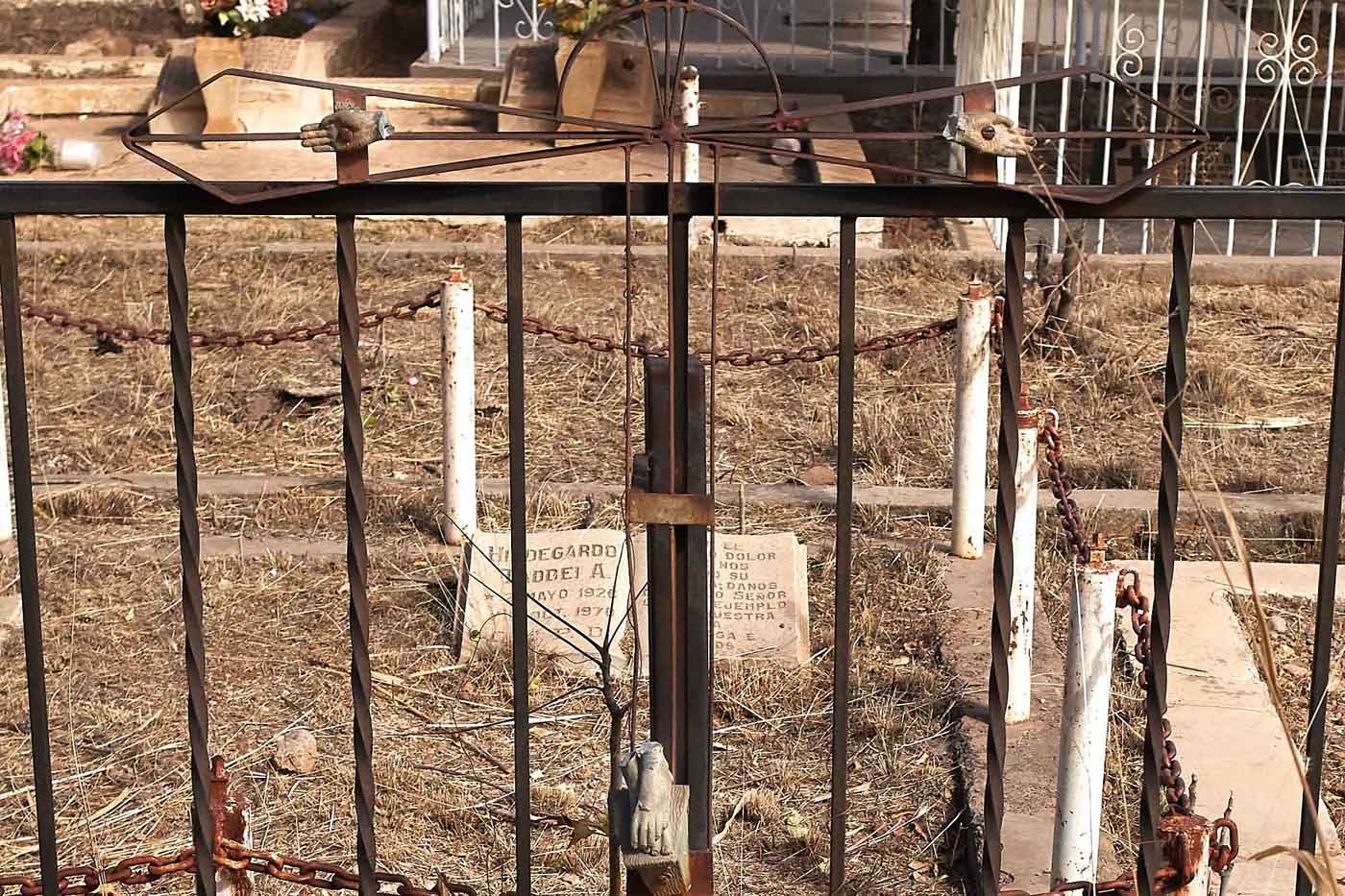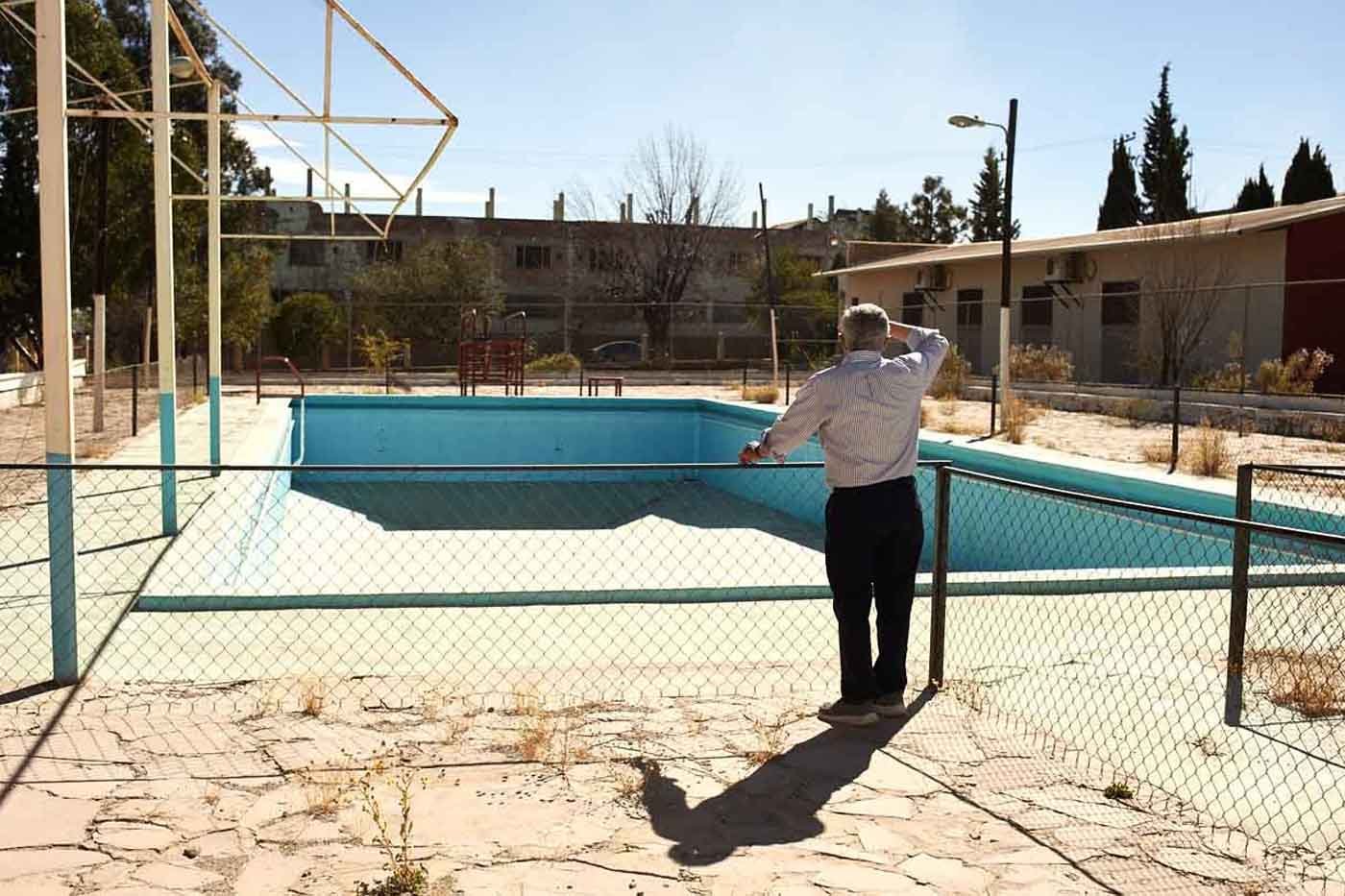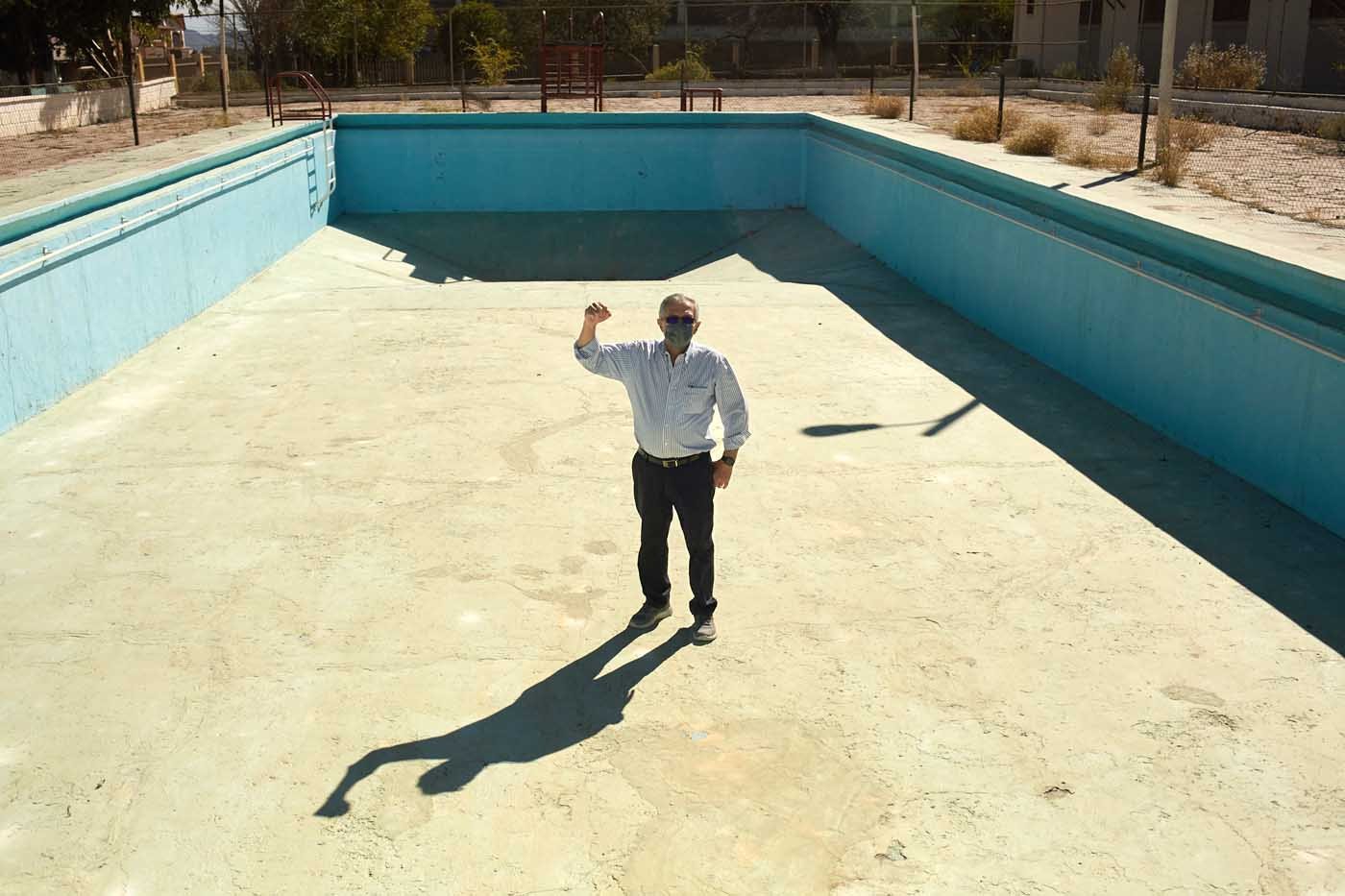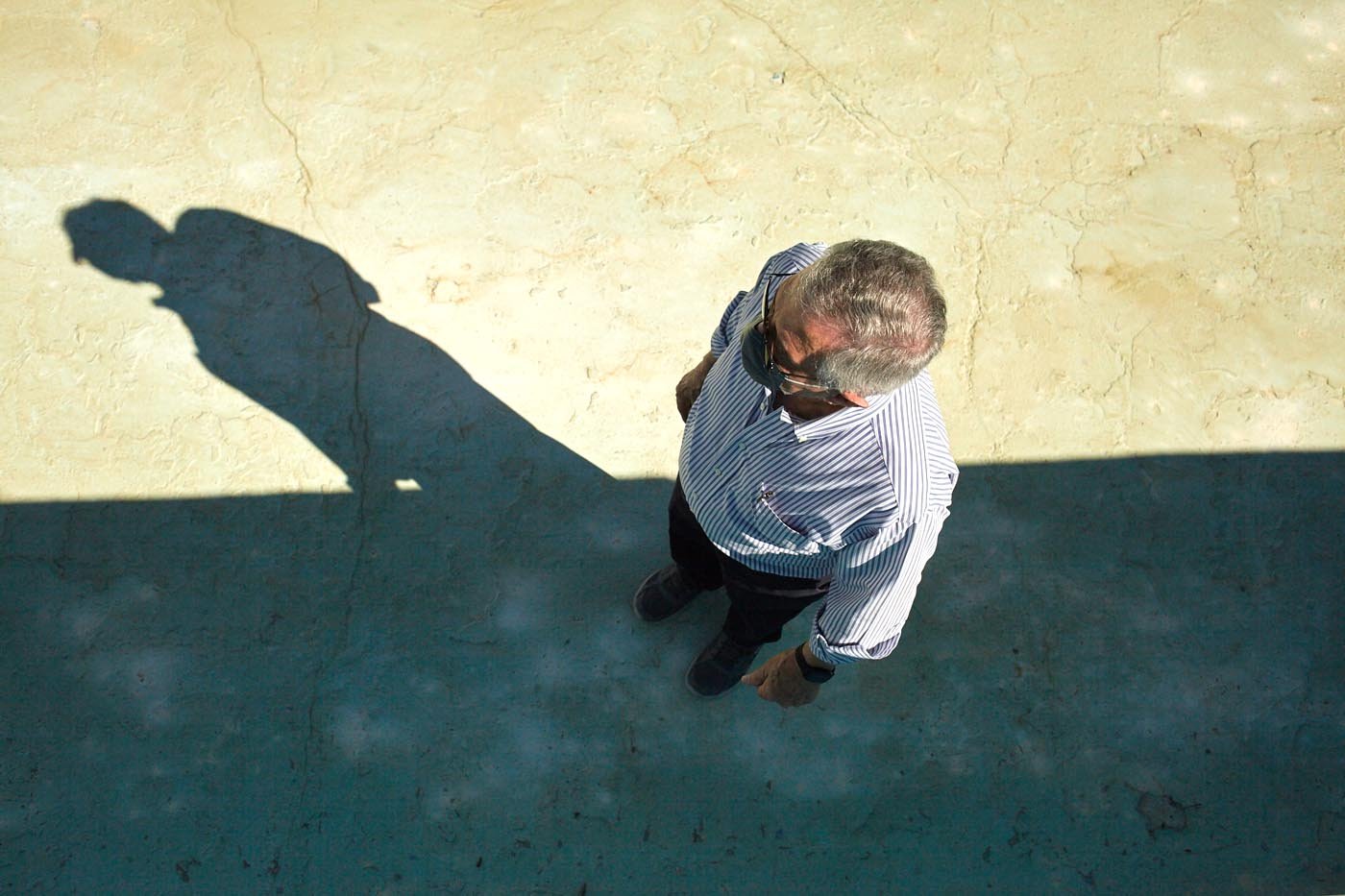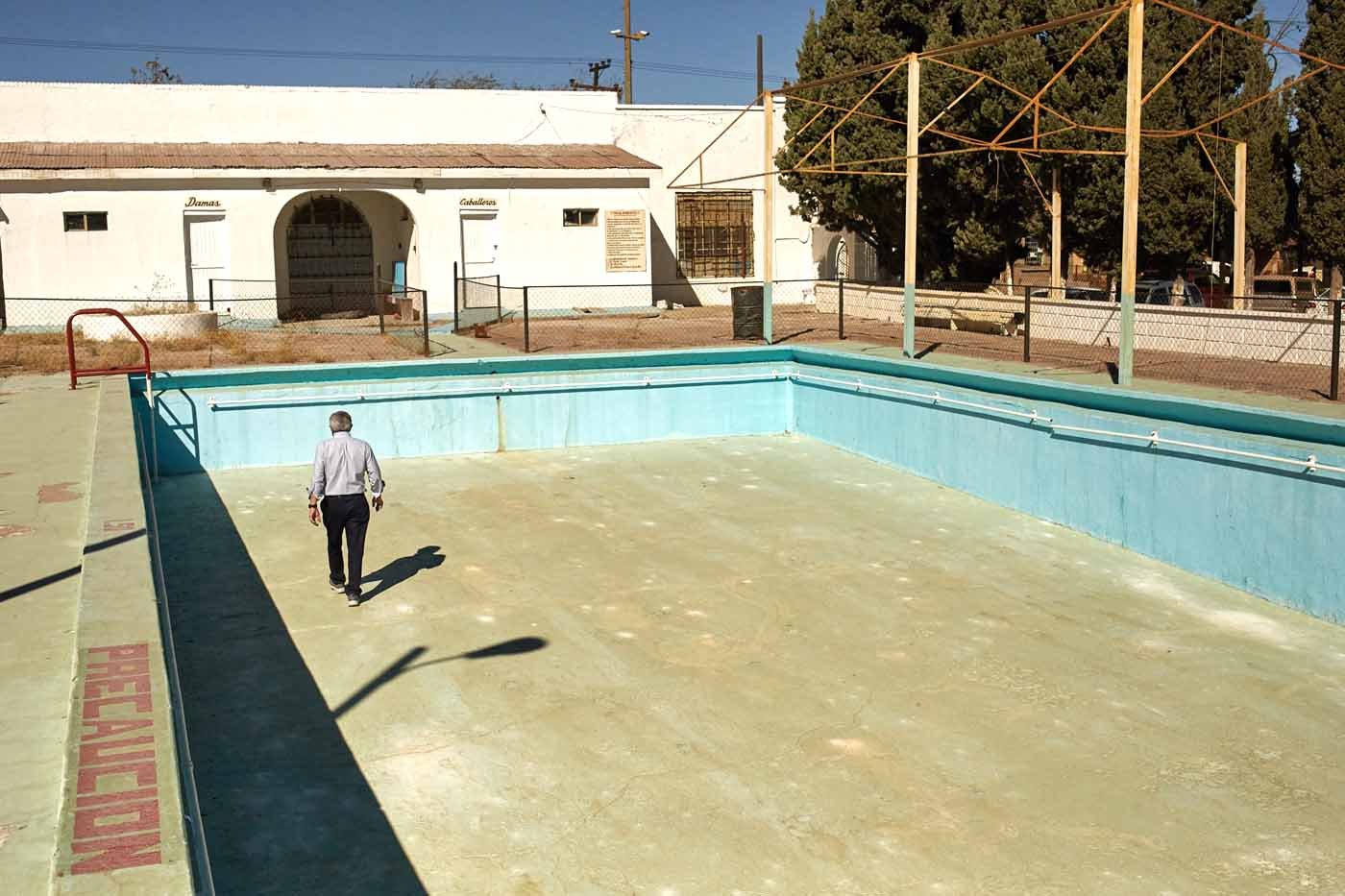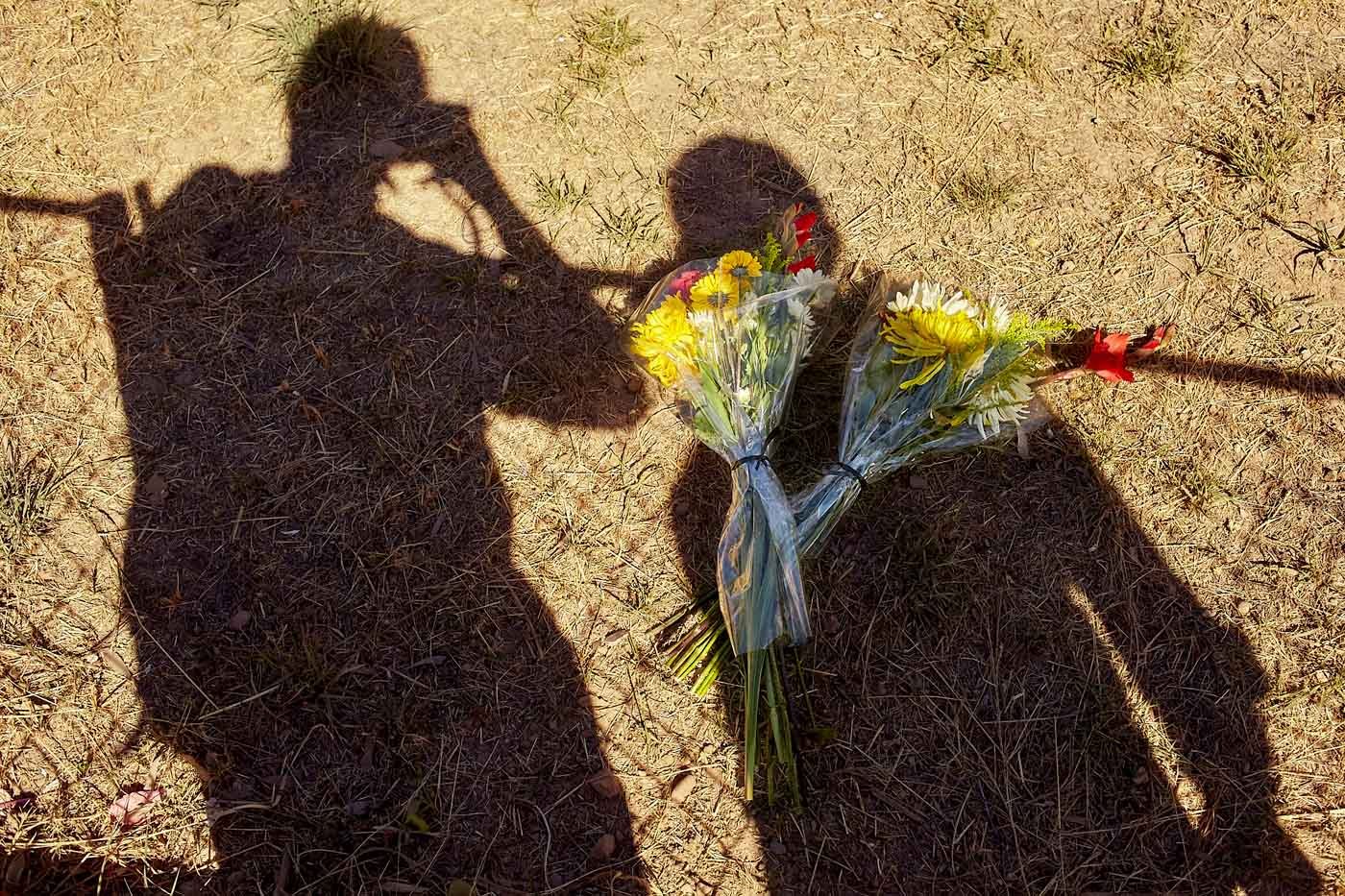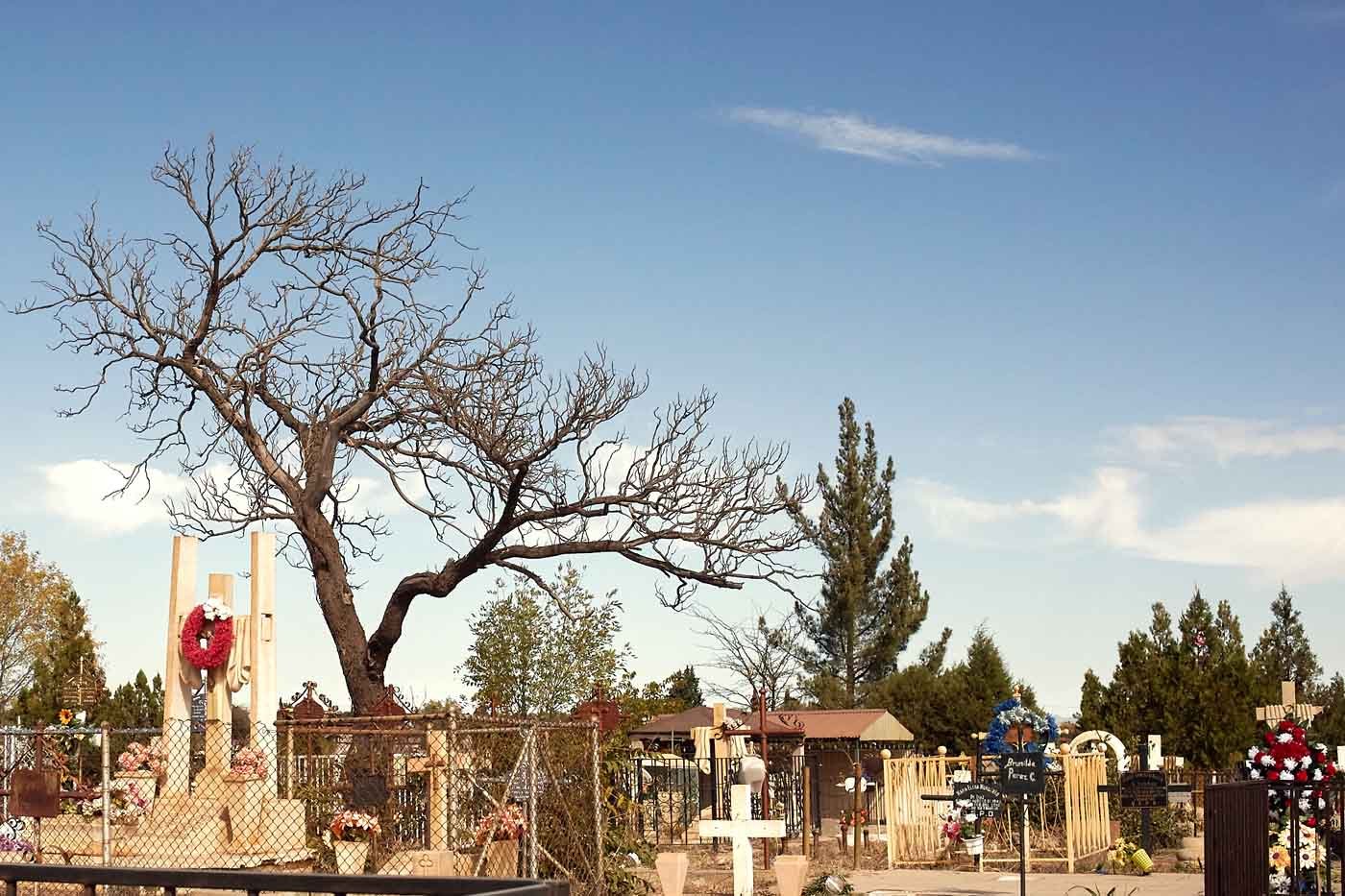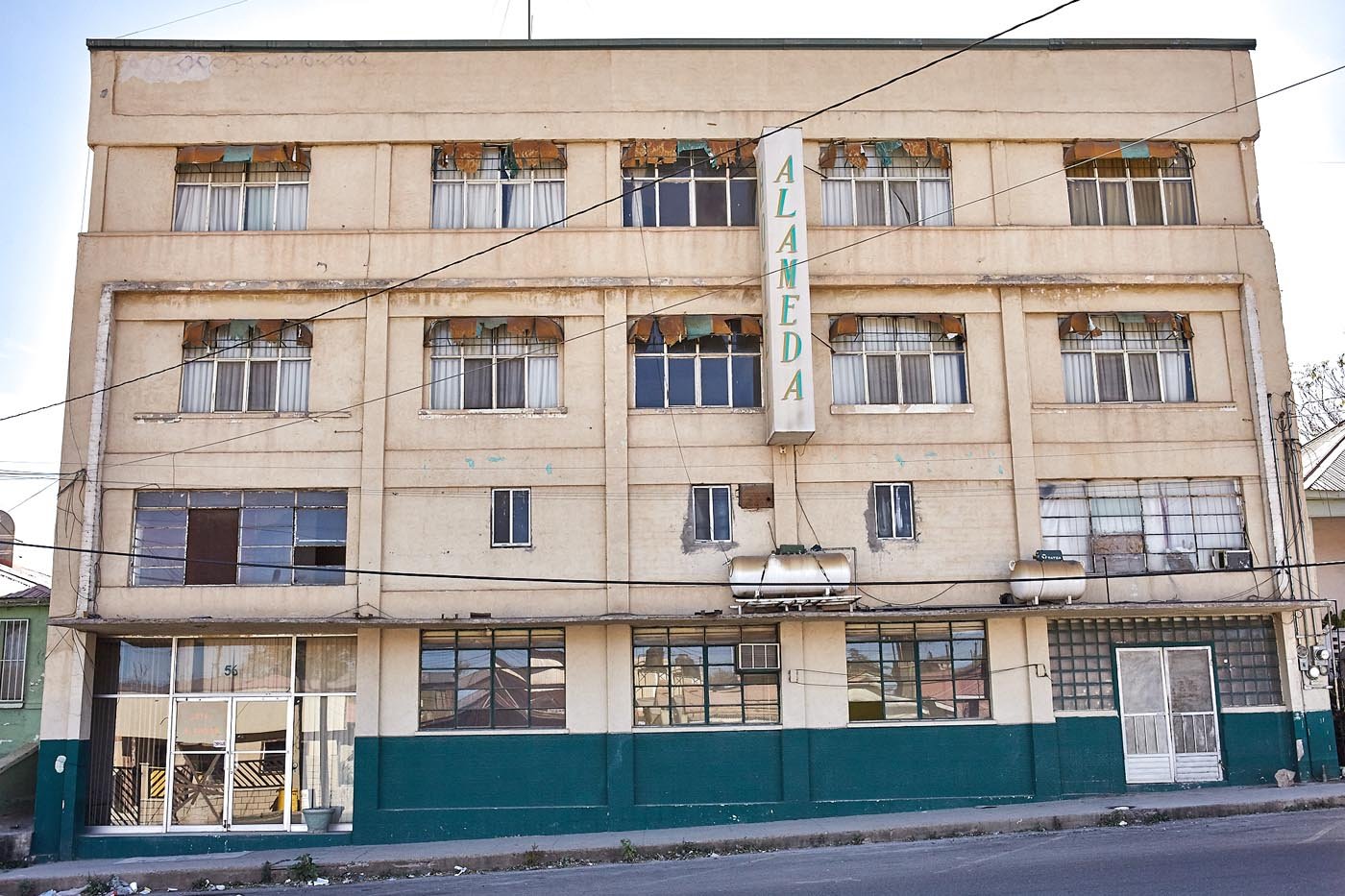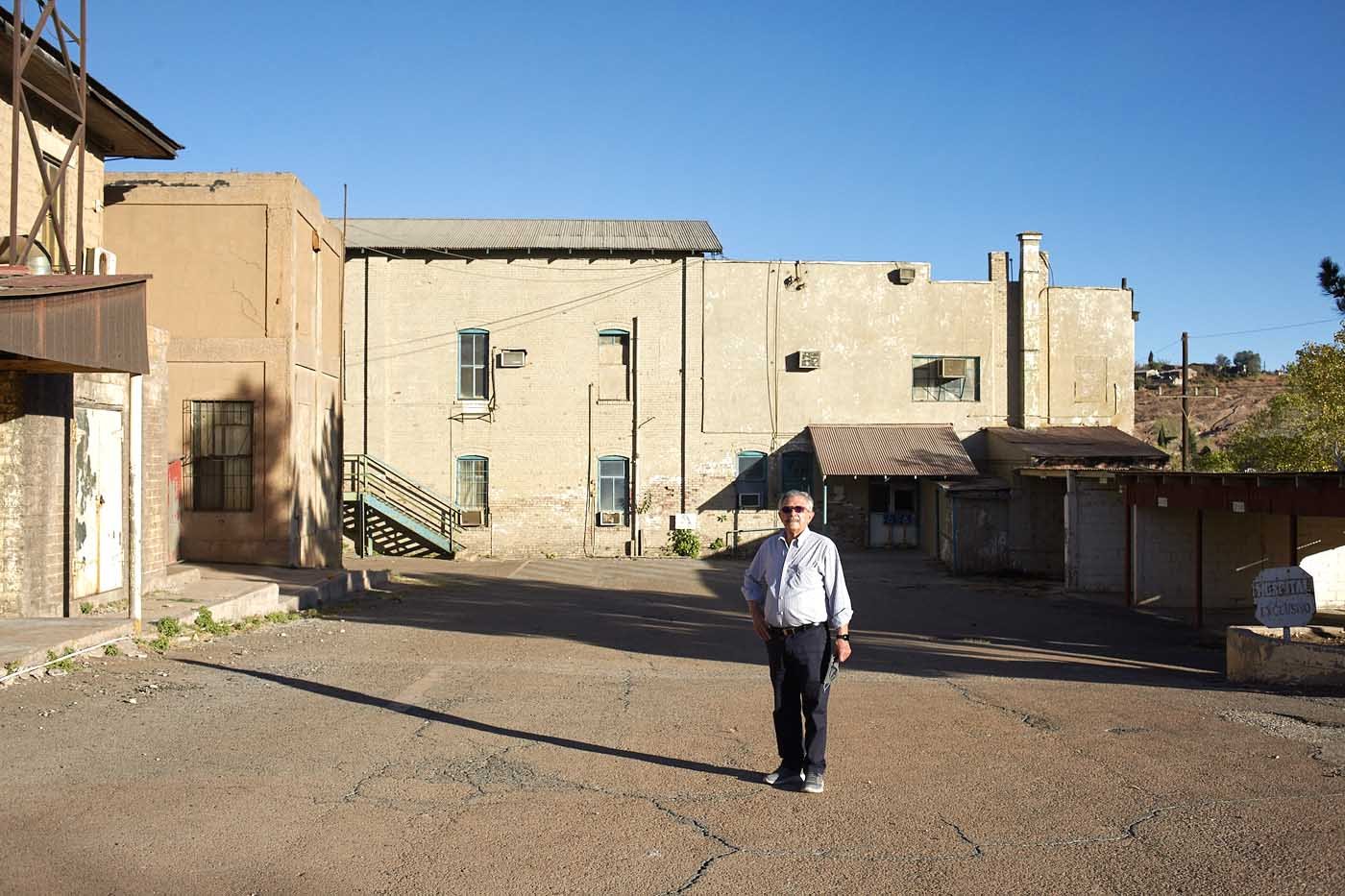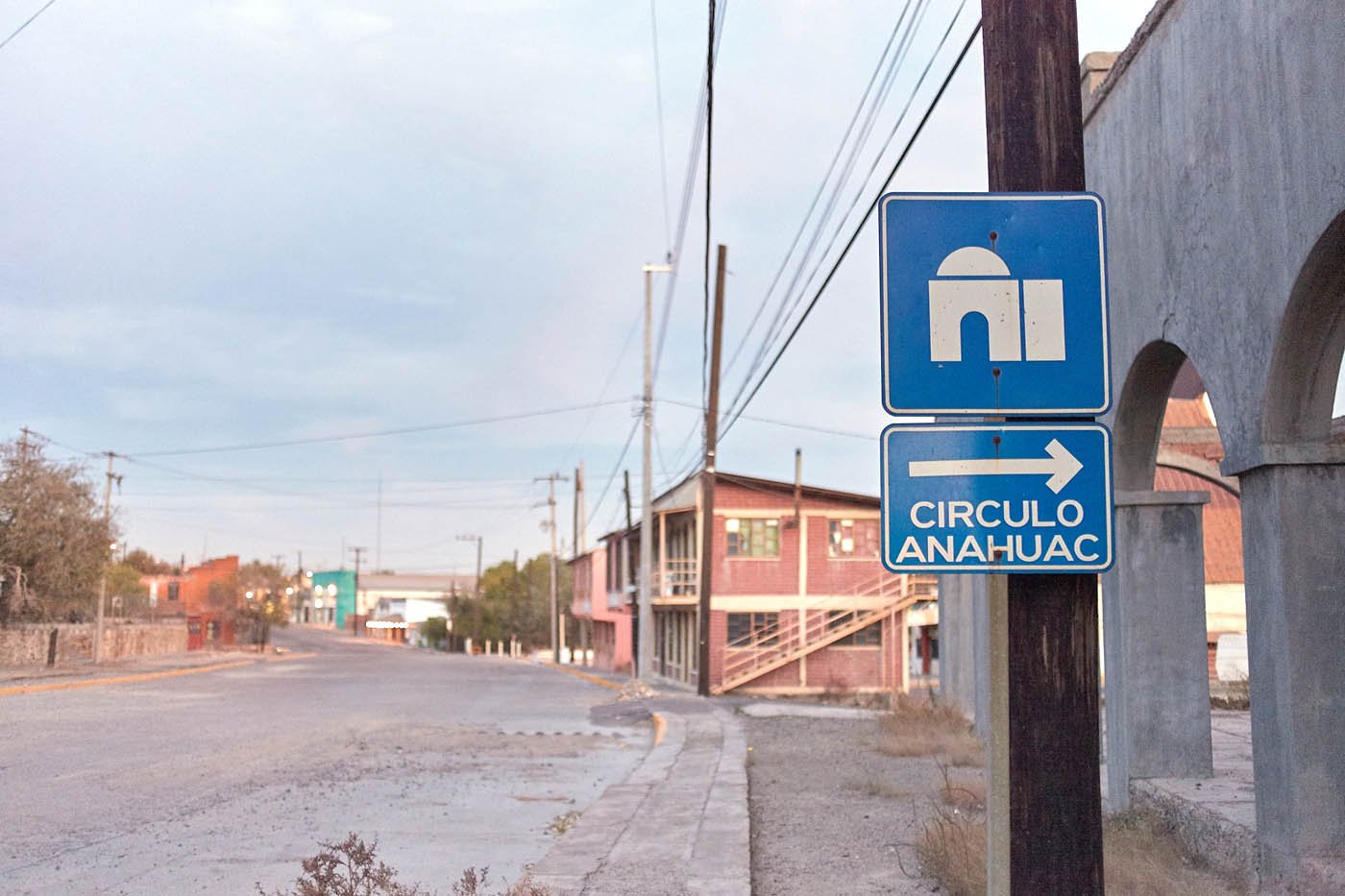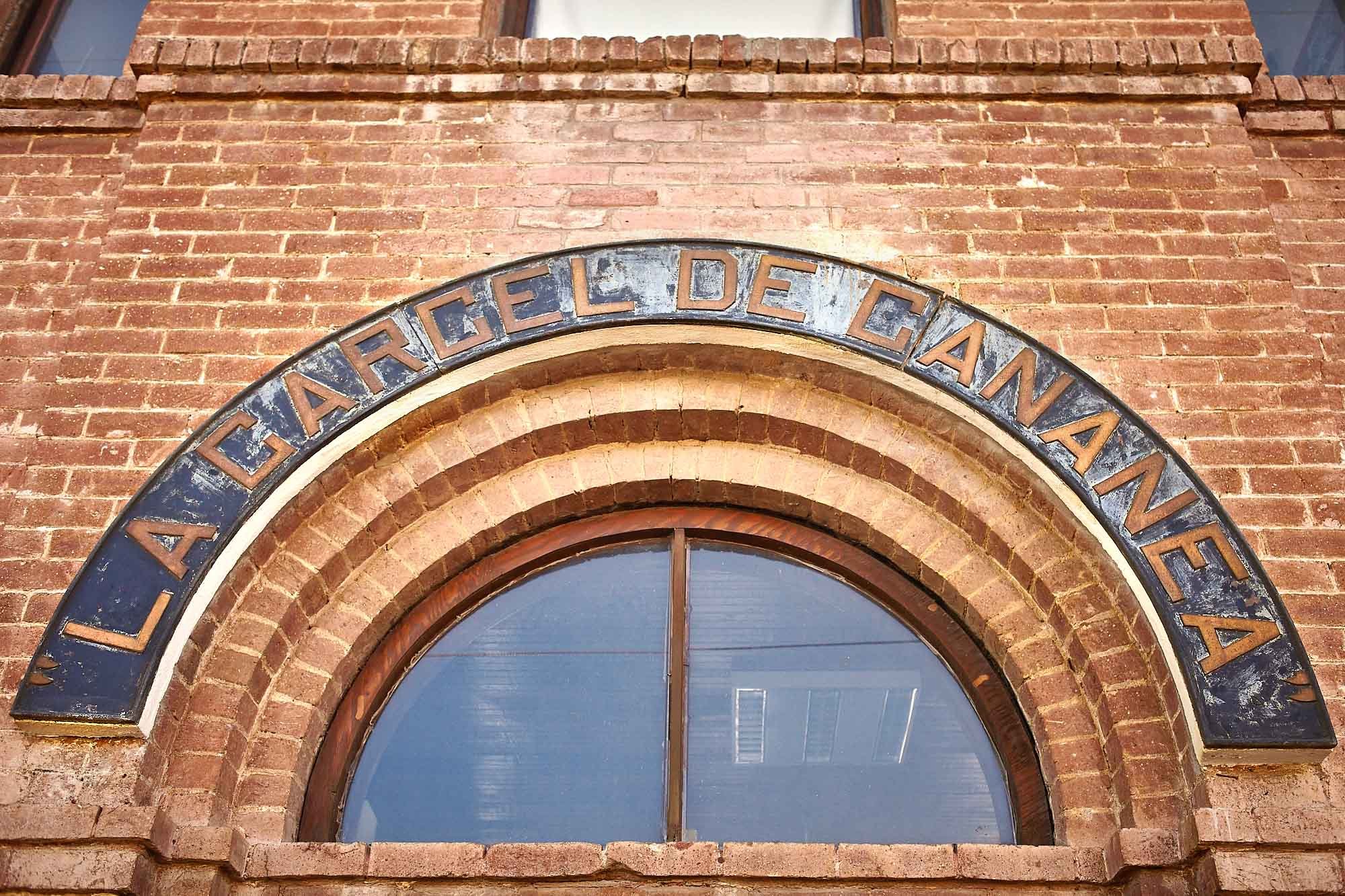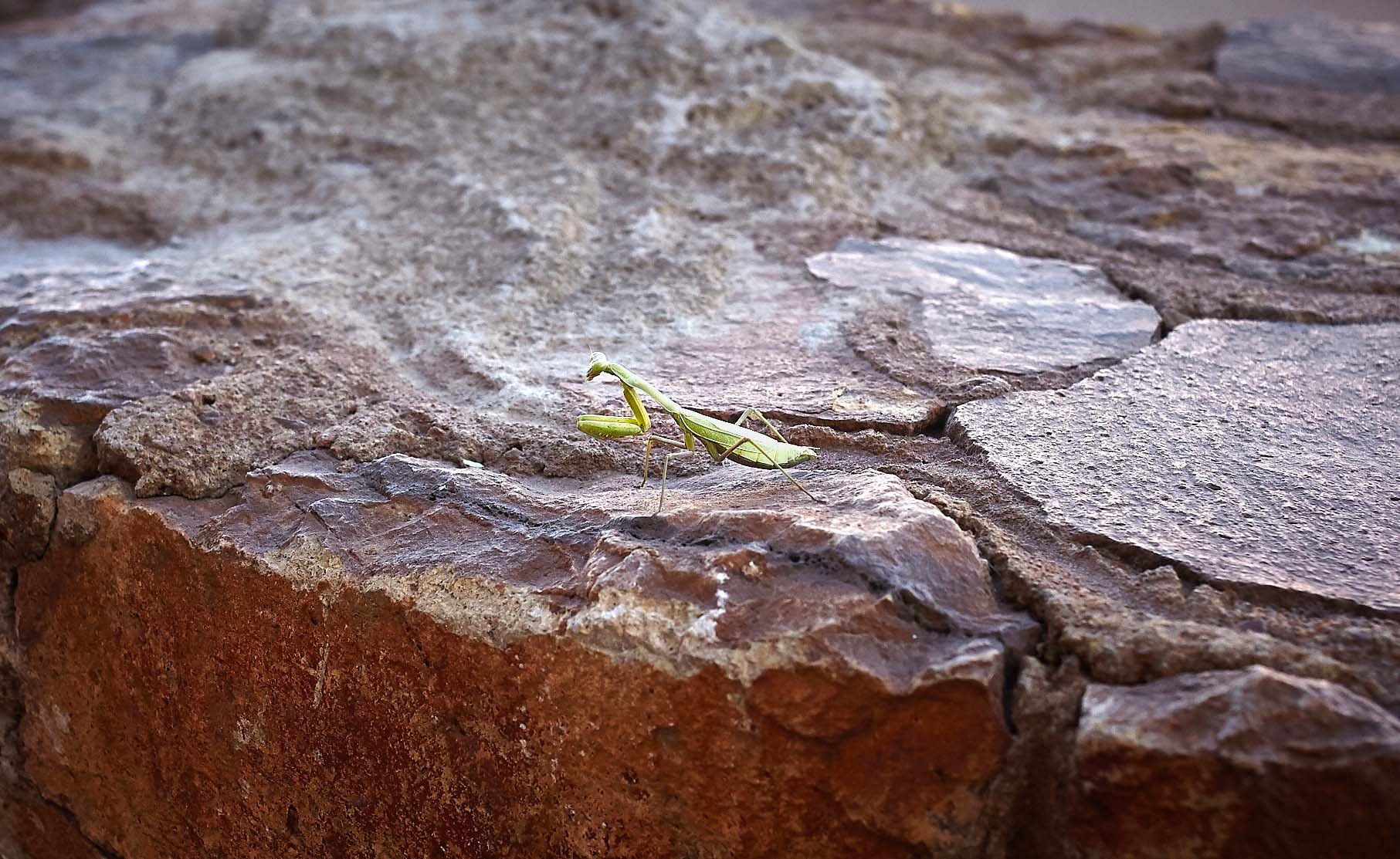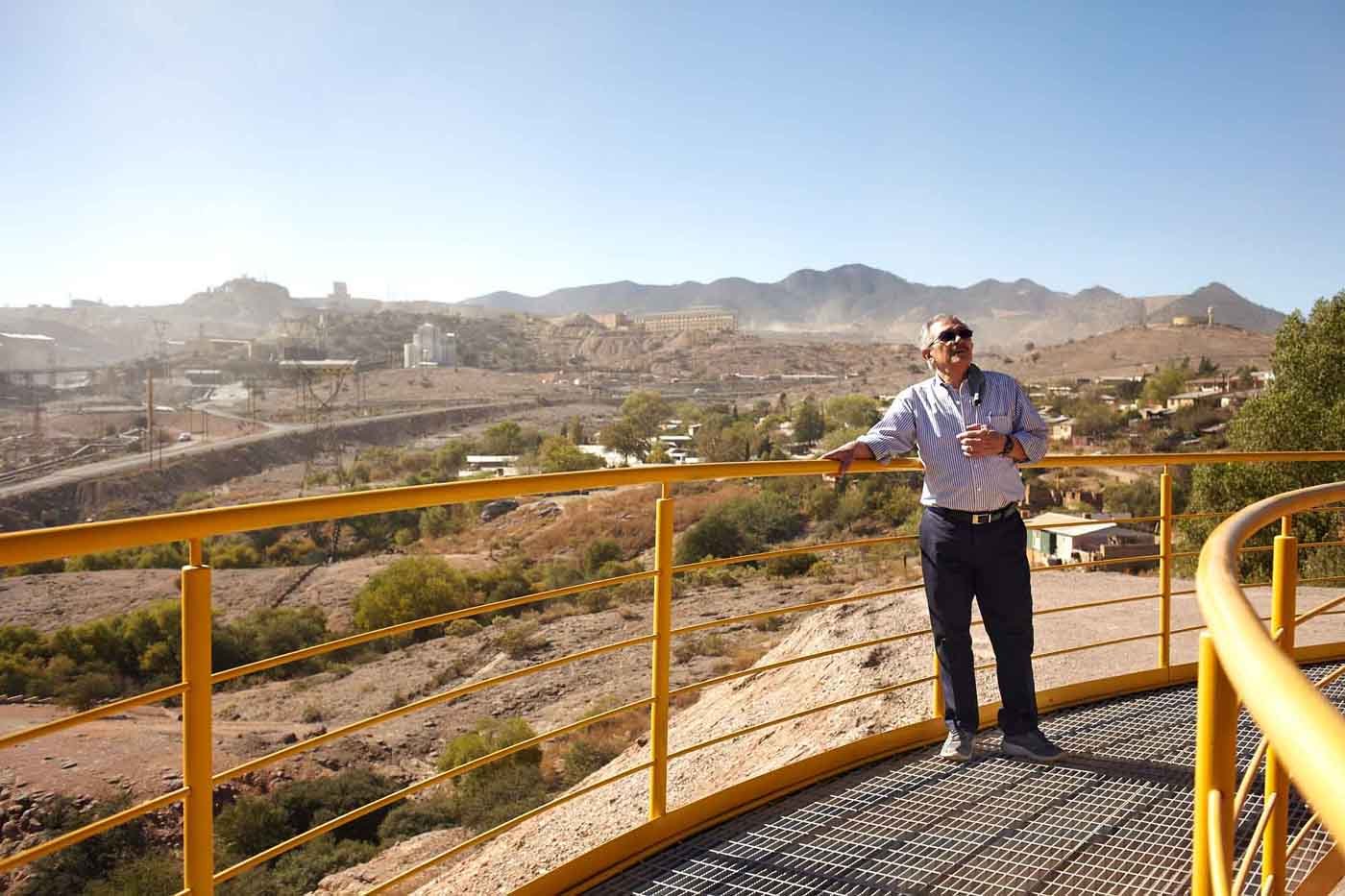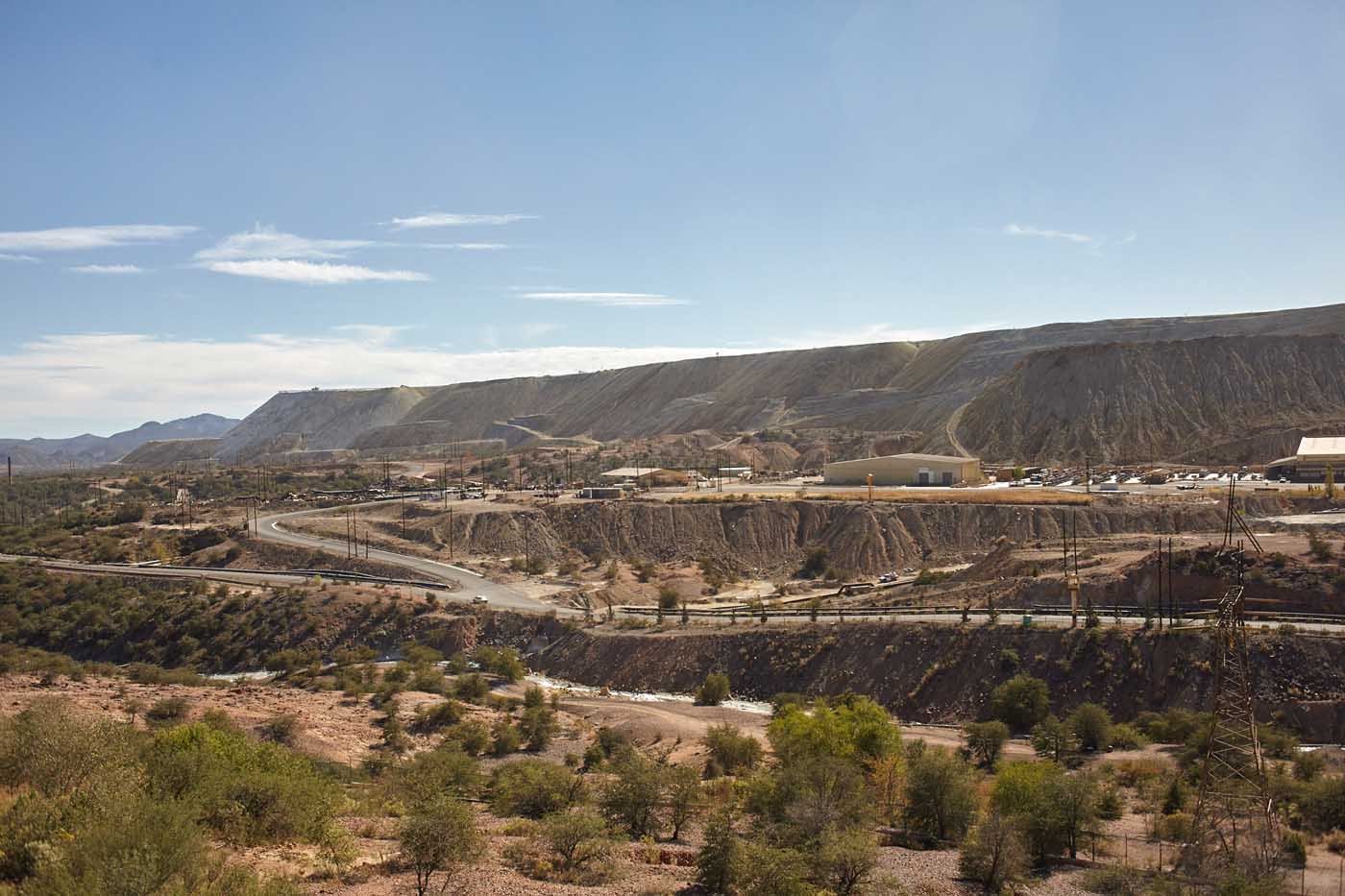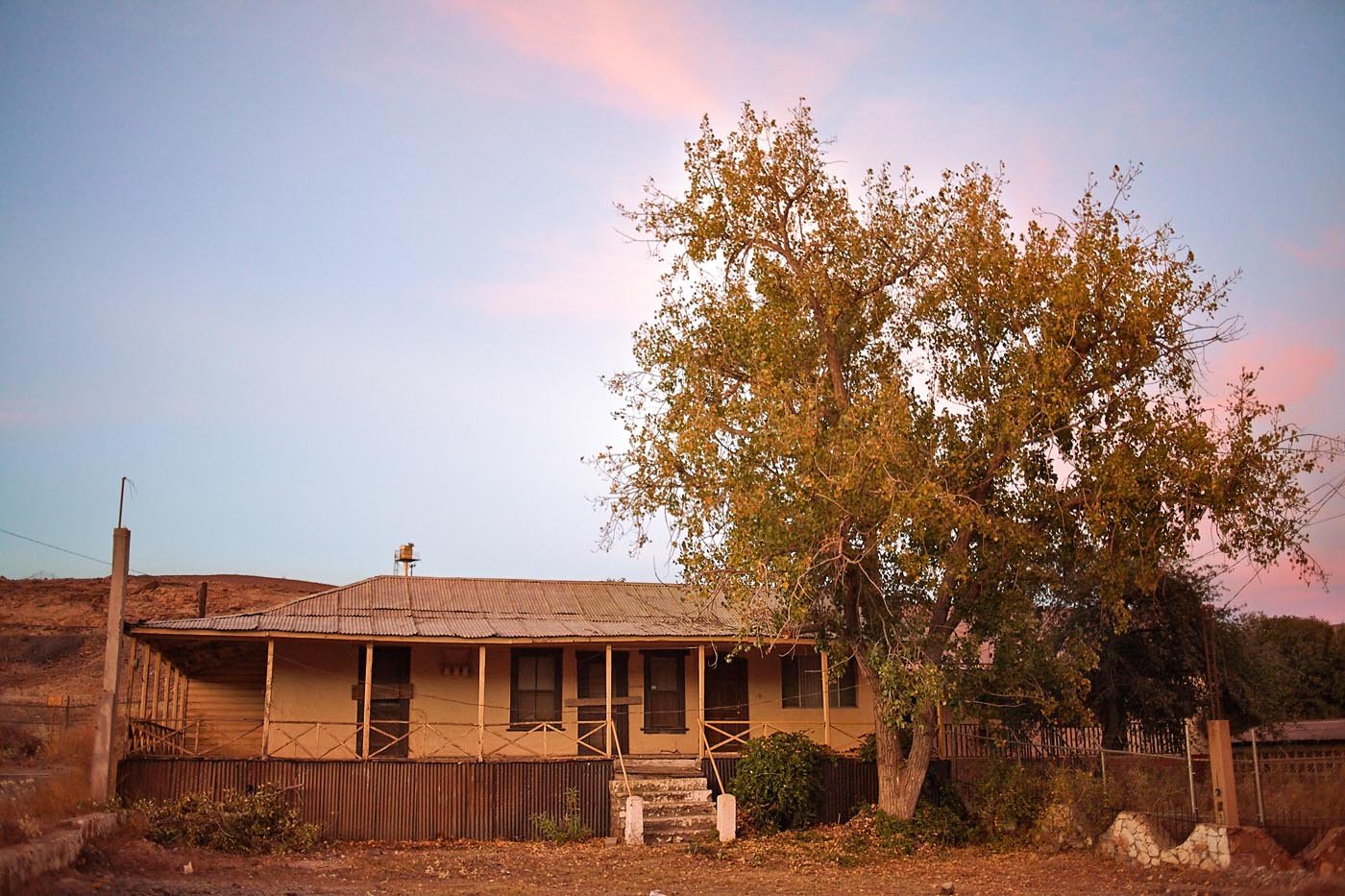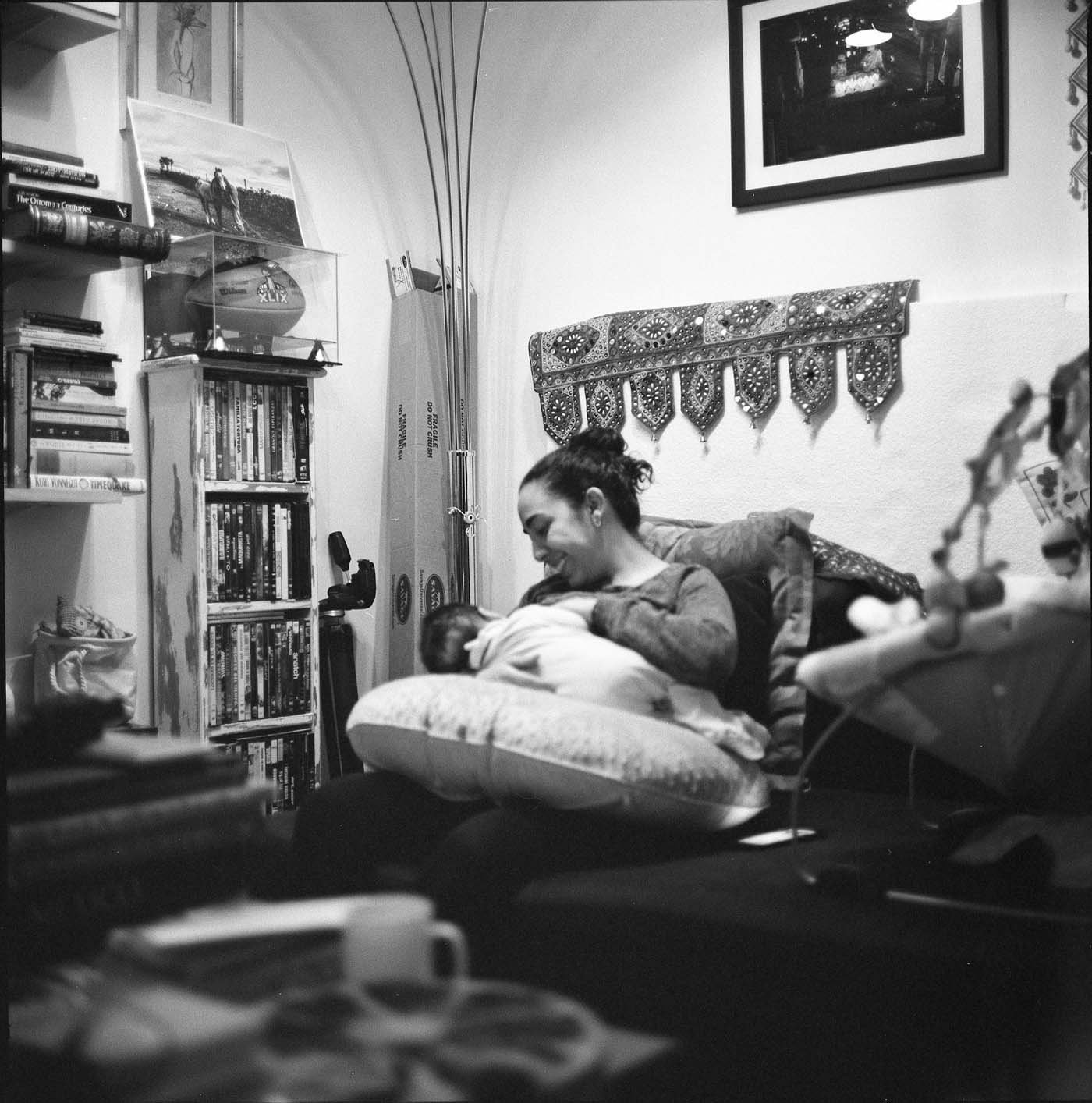The disappearing act of life.
“Erosion” is a photographic series reflecting on how places, people, family and memories change only to fade away before our eyes. This project took on a life of its own while attending my grandmother’s 100th birthday when a short trip to a dusty mining town presented me with the disappearing act of life.
My grandmother Leonor on her 100th birthday.
This mine used to be known as the Cananea Consolidated Copper Company back in 1900, a mining operation that literally moved mountains as they were ground to dust in search of copper. Buenavista, the town where my father was born, once sat on those mountains. Nothing remains of it.
The plan was to take a road-trip on an old route my father used to travel in his youth working as a truck driver for my merchant grandfather. At an early point we stopped at a river crossing where he had been stranded for three days eating only cinnamon cookies. That happened in 1962 and it became a fun family anecdote.
After a minute of wandering around the crossing, I noticed a pair of crosses on the edge of the road. A young couple had died there in 2004. The loving eulogy messages written on their crosses had a great impact on me. It dawned on me how territory changes in meaning: what had been a fun story about my father's youth, was now a memorial. A place of deep grief and loss for others.
I watched my 80 year old dad reading those eulogies and for the first time the idea that one day he'll be gone felt real in an almost tangible way. With that revelation lingering in my mind, we kept going. It made me reflect on the concepts of legacy, transcendence and if they even matter at all. Not like characters making it into the annals of history, but in a more immediate way: father to son. It made me realize what a small step in time a generation is. I thought of how my deceased grandparents had only been mentioned a few times over the last decade.
While being an exercise of thoughts on life, death and impermanence, this series is also an uncertain cry that screams "I'm here!", in the hopes that maybe down the line when -if- someone ever stumbles on to it, an echo will say "This man was here."
These are stories from my Erosion photo series. Featured here is Cananea, a small mining town in the northern sate of Sonora, Mexico. These are short anecdotes about living, passing away the small things in life, accompanied by photographs of people, places or keepsakes eroded by time.
STORIES INDEX
Lupita & Dario By The River •A Grave Visit • About The Public Pool Where My Father Learned To Swim • Alone In Life, Alone in Death • This Is The Alameda • Hidden Car & The Pinboy • Praying Mantis Jail •Where Your Home Is Buried • The Alchemy Of Memories •In A Split Second
Click on photographs to enlarge.
Lupita & Dario by The River.
In 1962 this was a dirt road and a funny story about my father being stranded here for days eating only cinnamon cookies became part of our family history.
My father used to drive an 8-ton truck for his father’s business, selling flour, salt, grains, and other goods across the state. On that occasion, the Sonora River had overflowed onto surrounding creeks. He was unable to cross at this point, between the city of Hermosillo and his town, Cananea. After previously spending one day waiting for the water to lower in the Tahuichopa crossing, he then had to stay two more days here, eating only what was available from the shipment he was carrying: cinnamon cookies.
Sixty years later, I traveled with him to Sonora to revisit his long gone journeys. We made the same route only this time out, the road was paved. The drive from Hermosillo to Cananea is about three and a half hours long. Back when this anecdote happened, it took about half a day or more, depending on the weather. The second time around, it took us a good nine hours to make it. We were enjoying the view, stopping here and there as my father remembered more things about the terrain and the times.
We also found these crosses in remembrance of a young couple who many years later died here. It’s normal to find crosses along the roads in Mexico. They’re regularly placed there after a car accident. These seemed to be there for another reason. We talked about it for a while and concluded that the couple probably drowned. It made more sense. It was then that it struck me.
The idea of how territory changes not only in geography but also in meaning hit me hard and became this new series, “Erosion”, about how our individual space and understanding of the world changes through time only to fade away right before our eyes.
The reason we were in Sonora in the first place was to celebrate my grandmother’s 100th birthday. Just two days prior, there had been a big gathering where she laughed, joked, sang, and clapped to absolute delight. I hadn’t seen her in years; I hadn’t seen anyone in years. And now I was here, standing in the middle of the road with my 80-year-old father, reading eulogy inscriptions on the crosses of a young couple that died in their 20s.
I understood life was eroding before my eyes.
I had been wanting to make this trip for at least 10 years. Why did it take so long? How is it that life moves so fast? Or is it that I move so slow? Even worse, would I’ve made this trip if my grandmother hadn’t turned 100?
I went on this road trip thinking I’d bring back some “gems from the past”, memories as magical postcards of life from a distant era. Instead, I found myself firmly grounded in a present that I’d been utterly oblivious to. It was as if ghosts had put up blatant picket signs so I could finally see. Here! You moron! Here! This is where your time goes! It goes in the ground never to be seen again!
Dario’s cross has her name and Lupita’s has his name.
Dario Armando
Your passing pains us deeply, but we know that wherever you are, you love each other. We lovingly remember you, sweeties.
From your mother-in-law and little brothers-in-law.
Guadalupe Yadira
Your matrimony was always and exemplary one and you loved each other so, that not even death could part you. And we’ll always love you. Mommy and brothers.
Excuse my translation, these inscriptions read so much more loving in their original language, Spanish.
Dario Armando
Nos Duele mucho su partida, pero sabemos que dónde quiera que estén se siguen amando, con cariño recordamos a los amorcitos. Recuerdo de tu suegra y cuñaditos.
Guadalupe Yadira
Fueron siempre un matrimonio ejemplar y se amaron tanto que ni la muerte los pudo separar. Y siempre los amaremos, tu mami y hermanos.
I used to fondly remember the Cinnamon Cookies anecdote, now I love it for the “epiphany” from this past trip. I’m grateful I could see and walk in the actual crossing where it all took place so long ago. Not even my father thought he’d ever set foot there again, but sixty years, a 2-hour flight and a 4-hour drive later, we made it. And there to greet our fun anecdote were Dario and Lupita.
I’m glad we won’t ever regret missing out on driving up there.
—
Note. A random odd fact I learned on this trip: a weird recluse nicknamed Bear Feet used to live near this crossing; not bear paws, bear feet. It was because he had six toes in each foot, which makes no sense since bears have 5 toes. Except for pandas. He had nothing more than a small cornfield to sustain himself.
_______________________________________________________________________________
From my family series “Erosion”, reflecting on how places, people, family and memories change only to fade away before our eyes. Cananea, Sonora. Mexico.
(1) Crosses by the side of the road near the river crossing where Lupita & Dario died.
(2) Sonora River crossing where my father was stranded in 1962.
(3) My father points in the direction where an odd recluse - a man they called Bear Feet- lived off his small cornfield.
(4) My father remembering the how high the water levels were the day he got stranded.
(5) My father reads the eulogy written on the crosses by the road.
A Grave Visit
My grandfather’s grave was vandalized years ago. He was a notable character in the mining town of Cananea, Sonora. He was known for providing groceries to all the miners on a long strike in demand of fair wages; there’s even a street named after him. Robbers took the marble that covered his grave and managed to tear off the bronze Christ from the cross over him, leaving only hands and feet. Curiously enough – and we think unrelated- the street signs in his name have also gone missing.
My father is the oldest of ten siblings and this is the first time in close to thirty years that he’s been here. Before he was born, his older brother passed away as a child around one year old in 1939. It was a tremendous blow to my grandfather who -before marrying my grandmother- had separated from a woman who couldn’t bear children.
I let a couple of months pass before I showed him these photographs and asked what he thought of them. He said he was perplexed by how bad the situation had gotten in town, so much that some people had to resort to stealing from graveyards. He was sad of how abandoned the whole cemetery was, how graves were there left never to be tended. It was a disheartening sight.
A short two day trip to a dusty town presented me with the disappearing act of life under the erosion of the sandpapers of time. It made me realize what a small step in time a generation is.
We were looking at the photos conversing and I casually mentioned, “you know, this was the closest thing to the three of us being together in one place…” He paused and replied “yeah… well, will you look at that”.
_______________________________________________________________________________
From my family series “Erosion”, reflecting on how places, people, family and memories change only to fade away before our eyes. Cananea, Sonora. Mexico.
(1) My father looking at my grandfather’s grave.
(2) Hands and feet of the bronze Christ that was stolen from cross over my grandfather’s grave.
(3) My father reflecting on the visit to the cemetery after almost 30 years.
About the public pool where my father learned to swim…
Cananea, Sonora, Mexico. - This is the public pool where my father learned to swim as a kid. Almost 70 years later we traveled together to his home town and came here. He was reminiscing life as a kid in this place. He was showing me how things had changed as he mentioned a high diving platform that wasn’t there anymore. He turned serious and said “A boy drowned here when I was about 10 or 12, he was younger than me. He jumped off the platform and somehow got his foot stuck in the bottom drain. They couldn’t get him unstuck, they put a hose in so he could breath as they rushed to drain the pool but he didn’t make it. I can’t remember his name.” We left after that.
_______________________________________________________________________________
(1) My father looking at the pool where he learned to swim.
(2) My father, happy to get in the pool, strikes a victory pose.
(3) My father after remembering a tragic drowning from when he was a kid.
(4) My father walking to exit pool and leave.
Alone in Life, Alone in Death.
When I told my mother that we'd be going to Cananea Cemetery she asked us to take flowers to two graves: her grandmother Concha and my great-aunt Emilia. Concha died way before I was born, but I got to know my great-aunt Emilia when I was a child. She was a conservative, frugal woman. A nice lady with thick bifocal glasses seemingly tied to the unspoken rule of always wearing dark, muted colors. My mother tells me she had a beautiful voice and used to sing whenever someone played the piano. I didn't get a chance to hear her sing but can perfectly see her smile and hear her voice to this day. I also remember her being forever single. She passed away when I was about 15, seemed to me I hadn’t heard from her in a long time.
We weren’t able to find either of their graves as many of the tombstones and crosses that adorn them have fallen out of care and were illegible, broken or hidden under dirt and weeds. We symbolically left flowers at an unmarked grave space. We felt disheartened, wishing we had found either of them, but time had done its thing and stripped away names, adornments and other signs of life and caring.
Next day I drove to another city and met up with an aunt and told her we couldn’t find Emilia’s grave. She was happy that we went searching for her but also a little heartbroken that we couldn’t find her. She looked to the sky as she whispered “Dear aunt Emilia, alone in life and alone in death…”
I felt bad that even though we were only six or seven year olds, my cousins and I pranked aunt Emilia on occasion… I hadn’t felt that in ages.
_______________________________________________________________________________
From my family series Erosion, reflecting on how places, people, family and memories change only to fade away before our eyes. Cananea Cemetery, Sonora. Mexico.
(1) My father and I cast our shadows over the grave space where we symbolically left flowers for my mother's grandmother Concha and my great-aunt Emilia.
(2) View of a tree over Cananea Cemetery.
(3) My father reading the tombstone of older relatives we stumbled upon.
This is The Alameda
This is the Alameda Hotel in the small mining town of Cananea, Sonora in northern Mexico. This used to be the place to stay back in the day. My mother recalls it always being nicely kept and painted in a mint green color. It had the amenities of modern-day top resorts when it was a redesigned venue in 1957.
My father once went there for lunch in the early 1960s, only to be surprised by a famous singer-actor, Cesar Costa, walking in and sitting at the table next to his. Personalities like Jose Alfredo Jiménez and Libertad Lamarque also graced the Alameda.
Like with other places in my “Erosion” series, there’s a sad anecdote included. In the early 60s, wealthy hunters from Mexico City flew in looking to claim some bighorn sheep. They turned on the gas heater before going to sleep and closed the windows leaving no ventilation. Oxygen was consumed, the heater pilot went out and gas kept flowing causing them to asphyxiate in their sleep. Gossip and threats of legal action were the talk of town for a while. Nothing happened.
The Alameda is not an inch of what it was in its glory days. History hasn’t been gentle with it, but this is the first time I have actually seen it. When I was a kid I suffered asthmatic bronchitis and the time of year I traveled to Cananea -every year- was December. So I pretty much stayed indoors watching my cousins play in the snow while I waited for a “not so cold day” so I could join in. As a result, much of the places and events in town were just stories and conversations to me.
After almost 30 years of not setting foot in Cananea, I came to The Alameda by chance. It stands derelict, run-down like most of its surroundings. But I’m a lover of nostalgia and immediately think up images in my mind to veil it like a beautiful lady hailing from another time. The scars on the building hold some sort of enchanting aura for me. My eyes see hip people, interesting characters, walking out of its front doors under broken windows.
The thought of the good old days and my parent’s memories of it bustling with people, in a lit atmosphere, lingers in my mind like magic kept in a time capsule. I think of it all being gone while I’m still standing today. And I’m glad to be alive and able to pause, to take a step back, and take it all in.
_______________________________________________________________________________
From my family series Erosion, reflecting on how places, people, family and memories change only to fade away before our eyes. Cananea, Sonora. Mexico.
Hidden Car & The Pinboy
A little over half a century ago my mother pranked my father by hiding his car here. This parking lot was a dirt vacant lot in the 60s.
In 1964 my father bought his dream car: a red 1959 Ford Galaxie Skyliner hard top convertible. One afternoon while he was bowling at “El Circulo”, my mother casually drove by and spotted his car. She thought it’d be fun to hide it from him. Unfortunately for her, this was before pinsetter machines came into use and a pinboy on a break, saw what went down and informed my dad.
Next morning my dad went by my mom’s office and told her the car had been stolen, to which she faked surprise. He said police had found it earlier that morning…then proceeded to describe in detail how it had been vandalized. Her face worsened as he went on. He couldn’t keep up with it and with a nervous laugh he let her know the joke was on her.
It’s an anticlimactic ending, I know.
But there’s one thing: that car is still my dad’s dream car. The fact that he gave her keys to it in a time where he was known for being rebellious, makes me wonder how much in love he was… and how we all can be at some point in our youth. In my teen years on occasion he’d say things like “I was once your age, what you’re doing, I’ve done before, I know what you’re talking about.” And I’d always think he hadn’t the slightest clue. Now in my mid forties as I write this, I can’t help thinking his words were so true.
So many decades after the fact, this simple story weaved its way into my own memories, thoughts and reflections, changing my understanding of the world.
_______________________________________________________________________________
From my family series Erosion, reflecting on how places, people, family and memories change only to fade away before our eyes. Cananea, Sonora. Mexico.
(1) My father standing where my mother parked his “stolen car”.
(2) Another view of what used to be the vacant lot.
(3) Sign “El Circulo”, a private club founded around 1905.
(4) My father looking around the closed front entrance of “El Circulo”.
Praying Mantis Jail
I had a moment of serendipitous realization when I saw a praying mantis in front of the old 1906 Cananea Jail entrance. It’s weird how the mind works to relate things in a split second.
This jail is famous for having held political prisoners who back in the day contributed to igniting the 1910 Mexican Revolution a few years after a miner's strike. Injustice, oppression, rage and the clash of society are molten into one sign: “Carcel de Cananea”. Then I saw a Praying Mantis across the entryway. In many cultures these insects are symbols of inner peace, good omens, balance, courage and even thought to be divine messengers.
From the 1930s on to his passing in 1969, my grandfather owned a general store in Cananea. In the early 1940s there was another months-long miner strike and he opened a tab for the miners providing them with goods.
This jail that never meant much to me and an insect put some things into perspective that day. The mantis reminded me that earlier that morning I’d visited my grandfather’s abandoned and vandalized grave, witnessing in real-time how life and its physical manifestations are thinned down by the erosion of time.
There’s no one from our family in Cananea anymore, they passed away or left long ago.
I know my mind is connecting these dots because that's where I’m at in thought, but I can’t help being amazed by how these small coincidences can conjugate to provide some sort of epiphany pointing to the importance of being present in life and to live today.
Cananea Jail is presently a museum dedicated to the worker struggle and commemorates the miner’s strike, “Museo de la Lucha Obrera”. We went on a Tuesday, it was closed but we could hear a joyful cumbia playing inside.
_______________________________________________________________________________
From my family series Erosion, reflecting on how places, people, family and memories change only to fade away before our eyes. Cananea, Sonora. Mexico.
(1) The sign over the door of Cananea Jail.
(2) A Praying Mantis stands at the entryway of jail.
(3) The old door of the jail, present day Museum - Museo de la Lucha Obrera.
Where Your Home Is Buried
My father stands at a view point overlooking what used to be the 4C - The Cananea Consolidated Copper Company.
Behind him is a huge area where mountains used to be, but they’ve been mined and ground for copper.
This mastodon of a mining feat that began in the 1900s literally buried the town of Buenavista -where my father was born- displacing its inhabitants.
Over the years the mining debris has been dumped to form the enormous man-made flat mounds you can see in the images as I pan.
The huge “dompe” trucks used to haul waste, have enormous tires, their diameter almost the same as the width of the road. They’re so large that they can easily run over a regular size pickup truck by accident, drivers have to be top notch professionals.
Even with such technical prowess and hard work, Cananea is not bursting with economic growth. It looks unkept and feels in decline compared to when I was last there 26 years ago.
Seems like the only ones benefiting are corrupt syndicate leaders, politicians and corporate investors. Just like in the 1900s when it all began under the “laws” of the “wild west” with “Colonel” Green, founder of the original CCCC.
_______________________________________________________________________________
From my family series Erosion, reflecting on how places, people, family and memories change only to fade away before our eyes.
Cananea, Sonora. Mexico.
(1) My father looks at the structure of the new viewpoint. We had never been there. Behind him, the man-made mountains of debris that covered the town where he was born.
(2) A section of the mine that can be seen from the viewpoint.
(3) A section of the mine that can be seen from the viewpoint.
The Alchemy Of Memories
There’s a distinct beauty to the sunsets in this place; the sunsets in this life.
A subtle underlying sadness transforms into nostalgia, when the last light of day graces this little house abandoned in the sun. I love the alchemy of memories. A boarded-up postcard from my past tells me things have changed… but then again, they've not. We’re all a little house, bathing in the sun. Waiting on our dust.
_______________________________________________________________________________
From my family series Erosion, reflecting on how places, people, family and memories change only to fade away before our eyes.
Cananea, Sonora. Mexico.
In a Split Second
This is a photo of my wife and son in our Mexico City apartment, he was about 2 months old. Every single thing in the photo is gone.
We sold the sofa, lamp and tripod. Everything else was stolen when the truck with everything we owned was hijacked on its way to our new home in the south of the country.
Up on the left there’s a small painting. It’s a woman, her head as a crocodile and a reindeer, we bought it from an artist on the street in Oaxaca on a road trip before we married. Below it there's a photograph I was waiting to have framed, from a documentarian friend of mine. Under the photo there’s a Super Bowl XLIX football my wife won on a raffle. Over my wife, hangs a photograph I made in Vietnam during Full Moon festival in Hoi An, we had stumbled on to it. On the side there’s a decoration we got in Bangkok and below an India door head, or whatever they’re called. A ton of books -some more than 30 years old- that were given to me by my mother. The first coffee cups we bought together, a hand made drum where I was learning Lakota songs. The DVD shelf we re-painted together. Hand knit toys my mother in law made for my son. Outside frame you’d find another framed photograph I made in an alley in Hong Kong, a beautiful, detailed love legend Rama and Sita hand carved statue in white wood that we got in Indonesia on our first trip to Asia; a piece of the Berlin Wall, a page from an old Turkish book with golden leaves on a ship at high seas… a 1920s chair from my grandma. A huge laundry basket full of toys and gifts for my son brought by friends from as far as Iceland.
It was all just a fraction of the last 8 years of our lives together. All gone in a split second.
Three years after the fact, I got a message online. It was a picture of one of my stolen books that had my name written on it. The man that contacted me said he’d found it at a garbage dump four states away from where I was living at the time. He said “an old man at the dump has a lot of your books, I could send them to you… if you’d like.” I politely declined and blocked the account.
_______________________________________________________________________________
From my family series “Erosion”, reflecting on how places, people, family and memories change only to fade away.

